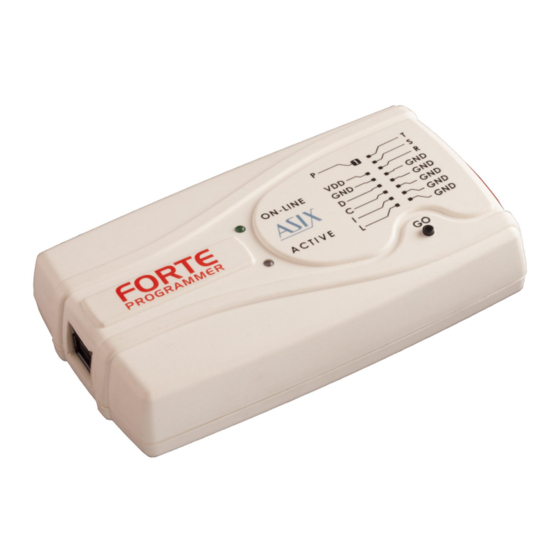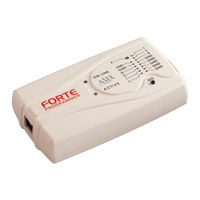
ASIX Forte Manuals
Manuals and User Guides for ASIX Forte. We have 2 ASIX Forte manuals available for free PDF download: Reference Manual
ASIX Forte Reference Manual (83 pages)
High-Speed USB Programmer
Brand: ASIX
|
Category: Computer Accessories
|
Size: 5 MB
Table of Contents
-
2 Forte
10-
Features10
-
Quick Start11
-
Use11
-
-
-
-
Atmel 805118
-
Cypress Psoc19
-
Stm821
-
-
Use24
-
-
-
Installation30
-
-
Projects31
-
-
Toolbar39
-
Status Bar39
-
-
Menus39
-
File Menu40
-
File ➙ New40
-
File ➙ Open40
-
File ➙ Save40
-
File ➙ Exit42
-
Edit Menu42
-
View Menu42
-
Device Menu43
-
-
Options Menu47
-
-
-
Number Base53
-
Next S/N53
-
Destination53
-
Sequence53
-
-
Help Menu54
-
-
-
Hvp57
-
Updating up65
-
-
Settings77
-
-
FORTE Tester81
Advertisement
ASIX Forte Reference Manual (102 pages)
High-Speed USB Programmer
Brand: ASIX
|
Category: Motherboard
|
Size: 6 MB
Table of Contents
-
2 Forte
11-
Features11
-
Quick Start12
-
Use12
-
-
-
-
Atmel 805121
-
Cypress Psoc22
-
Stm824
-
Hcs0825
-
Hcsxxx28
-
-
Drivers
32 -
-
Installation36
-
-
Projects37
-
-
Toolbar46
-
Status Bar46
-
Menus46
-
File Menu46
-
File ➙ New46
-
File ➙ Open46
-
File ➙ Save47
-
Edit Menu48
-
File ➙ Exit48
-
View Menu49
-
Updating up75
-
-
-
-
-
Data Record87
-
End of File87
-
Jtag Player91
-
SVF File91
-
XSVF File92
-
Settings93
-
Multiup97
-
Programming97
-
Commandline97
Advertisement

